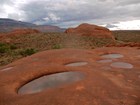Glen Canyon National Recreation Area is home to unique flora and fauna that make their home in smaller water sources and tributaries to the Colorado River and Lake Powell. This project assesses conditions of springs and seeps, fishes, tinajas, amphibians, and riparian zones in these areas and identifies drivers and stressors influencing their condition.
-
Glen Canyon National Recreation Area
Article 1: Condition of Glen Canyon's Tributary Rivers and Associated Resources: Natural Resource Assessment 2022

NRCA Overview: Glen Canyon National Recreation Area is home to unique flora and fauna that make their home in smaller water sources and tributaries to the Colorado River and Lake Powell. This project assesses conditions of springs and seeps, fishes, tinajas, amphibians, and riparian zones in these areas and identifies drivers and stressors influencing their condition. Read more
-
Glen Canyon National Recreation Area
Article 2: Small Water, Big Impact: Assessing the Health of Springs, Seeps, and Hanging Gardens
Glen Canyon National Recreation Area: Springs and seeps connect groundwater to the surface that plants and animals rely on throughout the desert. The Natural Resource Condition Assessment program partnered with Utah State University to evaluate the condition of springs and seeps and to identify data gaps. Find out how springs and seeps are doing at Glen Canyon and what threatens them. Read more
-
Glen Canyon National Recreation Area
Article 3: Native Fish in Glen Canyon’s Tributary Rivers

Glen Canyon National Recreation Area: Fish are an important part of aquatic ecosystems. They are an integral part of food webs; some are herbivores and others are carnivores. Nearly 30 species of fish inhabit the waters of Glen Canyon National Recreation Area. However, only eight of these species are native. Of the eight native fish species in Glen Canyon, four are listed as Endangered Species, and four are part of a conservation/management effort by local states. Read more
-
Glen Canyon National Recreation Area
Article 4: Water in the Rock: Tinajas in Glen Canyon

If you’re hiking in Glen Canyon National Recreation Area and come across a pool of water in the rock, chances are you’ve found a tinaja (pronounced "tihn-AH-hah"). Tinajas are depressions in the sandstone that hold water from rain and snowmelt. Smaller tinajas may dry out, but larger tinajas can retain water year-round. Large or small, tinajas are important, providing a potential water source in the arid desert for both animals and people. Read more
-
Glen Canyon National Recreation Area
Article 5: Amphibians in the Desert

Glen Canyon National Recreation Area: Although Lake Powell is one of the largest reservoirs in the U.S., not far from the lake shore is a very different and dry landscape. Amphibians, with their moist skin, must stay hydrated or they can die from desiccation. How difficult is it for amphibians to survive in the hot, arid environment that includes Glen Canyon NRA? How are amphibians doing at the national recreation area today? Read this article to learn more. Read more
-
Glen Canyon National Recreation Area
Article 6: Riparian Zones—It’s all about the Water
Glen Canyon National Recreation Area: More than 3,000 miles of waterways flow through Glen Canyon National Recreation Area—that’s more than the distance between Los Angeles and Washington, D.C.! The amount of water in this desert ecosystem depends mainly on annual snowpack and precipitation. Riparian plant communities along these waterways can be cattail/rush/sedge marshes, willows, or deciduous forests. The communities provide habitat and stabilize stream banks from erosion. Read more


